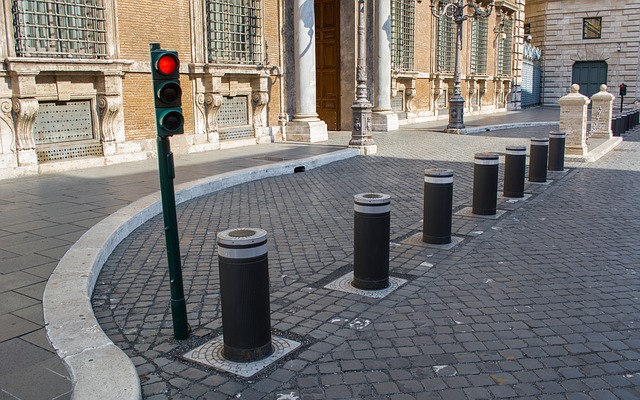Bollard

|
A bollard is an item of street furniture comprising a vertical post fixed into the ground at intervals to prevent vehicle access or to keep vehicles from using the pavement. Bollards can be up to a 1m high but are usually shorter. The intervals between bollards usually allow the passage of pedestrians, prams, cyclists and so on, although they may prevent the passage of trolleys at airports, supermarkets and so on. They can also be used as traffic calming measures to narrow the available space for vehicles to pass through, thereby slowing them down.
With the rise of terrorism in recent years, bollards are more frequently used in city centres to prevent vehicle ramming attacks and ram-raiding.
Bollards are available in various materials (cast iron, steel, concrete, timber, plastic etc), styles and colours and they can also be decorated. Cast iron was a traditional favourite, often with the crest of the city or local authority emblazoned near the top. Plastic bollards (usually red) which sit on the surface are frequently used by highway contractors during road works to separate the worksite from the road. Illuminated bollards can also be seen on traffic islands to provide pedestrian protection and to direct traffic in the desired direction.
The bollard has maritime origins from the time when old cannons were secured (open ends facing upwards and two-thirds buried) into the quaysides to provide a mooring point for ships. When bollards were subsequently purpose-made in the 19th century, they were often designed to have a cannon shape to reference their origins.
Recent years have seen the use of hydraulically-operated rise-and-fall bollards which allow entry at certain times or to certain vehicles e.g fire engines or police cars. When not required, the bollard can be made to descend into a buried housing, leaving its top surface flush with the ground. It is raised as easily when required. A more simple version, often found in car parks, involves a hinged bollard that can be locked in the upright position to prevent access to a parking space, or laid flat on the ground to allow authorised vehicles to park.
[edit] Related articles on Designing Buildings Wiki
Featured articles and news
RTPI leader to become new CIOB Chief Executive Officer
Dr Victoria Hills MRTPI, FICE to take over after Caroline Gumble’s departure.
Social and affordable housing, a long term plan for delivery
The “Delivering a Decade of Renewal for Social and Affordable Housing” strategy sets out future path.
A change to adoptive architecture
Effects of global weather warming on architectural detailing, material choice and human interaction.
The proposed publicly owned and backed subsidiary of Homes England, to facilitate new homes.
How big is the problem and what can we do to mitigate the effects?
Overheating guidance and tools for building designers
A number of cool guides to help with the heat.
The UK's Modern Industrial Strategy: A 10 year plan
Previous consultation criticism, current key elements and general support with some persisting reservations.
Building Safety Regulator reforms
New roles, new staff and a new fast track service pave the way for a single construction regulator.
Architectural Technologist CPDs and Communications
CIAT CPD… and how you can do it!
Cooling centres and cool spaces
Managing extreme heat in cities by directing the public to places for heat stress relief and water sources.
Winter gardens: A brief history and warm variations
Extending the season with glass in different forms and terms.
Restoring Great Yarmouth's Winter Gardens
Transforming one of the least sustainable constructions imaginable.
Construction Skills Mission Board launch sector drive
Newly formed government and industry collaboration set strategy for recruiting an additional 100,000 construction workers a year.
New Architects Code comes into effect in September 2025
ARB Architects Code of Conduct and Practice available with ongoing consultation regarding guidance.
Welsh Skills Body (Medr) launches ambitious plan
The new skills body brings together funding and regulation of tertiary education and research for the devolved nation.
Paul Gandy FCIOB announced as next CIOB President
Former Tilbury Douglas CEO takes helm.
UK Infrastructure: A 10 Year Strategy. In brief with reactions
With the National Infrastructure and Service Transformation Authority (NISTA).






















